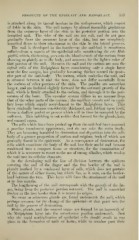Page 547 - My FlipBook
P. 547
PRODUCTS OF THE EPIBLAST AND MESOBLAST. 557
is attached along its lateral borders to the nail-grooves, Avhieh consist
of folds in the skin. The nail merges by almost insensible gradations
from the corneous layer of the skin in its posterior portion into the
hornified nail. The sides of the nail are not soft, and do not pass
gradually from the corneous layer of the skin, but are completely
hornified down to their attachment to the skin in the lateral grooves.
The nail is developed in the hmnla—as the nail-bed is sometimes
called—from a matrix of the epithelial cells constituting the vete Mal-
pighii, which, thickening, prevents the blood-vessels of the corium from
showing so plainly as in the body, and accounts for the lighter color of
that portion of the nail. Between the nail and the corium are seen the
infant cells of the Malpighian layer, constituting only a single layer
near the free margin, but gradually becoming thicker toward the poste-
rior part of the nail-body. The corium, which underlies the nail, and
is situated between it and the bone, does not diifer essentially from
the corium of other portions of the skin. The papillae are somewhat
longer, and are inclined slightly forward by the outward growth of the
nail, which is firmly attached to the corium, and through it to the peri-
osteum of the bone. The vascular system differs in no manner frcjni
that of the other parts of the corium ; the capillary vessels end in ca})il-
lary loops which supply nourishment to the Malpighian layer. This
layer gradually becomes considerably thickened, and, folding upon itself,
forms a shalloM^ pocket or groove which will in time be occupied by the
nail-root. This infolding is not unlike that formed for the glands, hair,
and enamel organ.
The cells which have been pushed up from the nail-bed have assumed
a peculiar translucent appearance, and do not take the stain freely.
They are becoming hornified by desiccation and deposition into the cell-
body of a greater proportion of carbon and sulphur, both of which are
generallv found in the epidermis. As a consequence of desiccation, the
cells which constitute the body of the nail lose their nuclei and become
condensed into a compact tissue or structure, for the examination of
which it is necessary to resort to the use of strong alkalies, which resolve
the nail into its cellular elements.
In the developing nail the line of division between the epiderra
coverino; the end of the finger and the free border of the nail is
plainly marked by a condensed layer of cells, which does not partake
of the nature of either tissue, but which lies, as it were, on the border-
land between the two. This layer will form the attachment of the nail
at its free margin.
The lengthening of the nail corresponds with the gro-s^iih of the fin-
ger, being from the posterior portion outward. The nail is somewhat
thicker at the free border than it is nearer its origin.
No sweat or sebaceous glands are found underneath the nail, which
perhaps accounts for the change of the epidermis at that point into the
nail by the process of desiccation.
Hairs, glands, and the enamel organ are formed by an ingrowth of
the Malpighian layer into the mesodermic portion underneath. Just
why the rapid multiplication of epithelial cells should result in one
place in the formation of nails or horns, while in another part their


